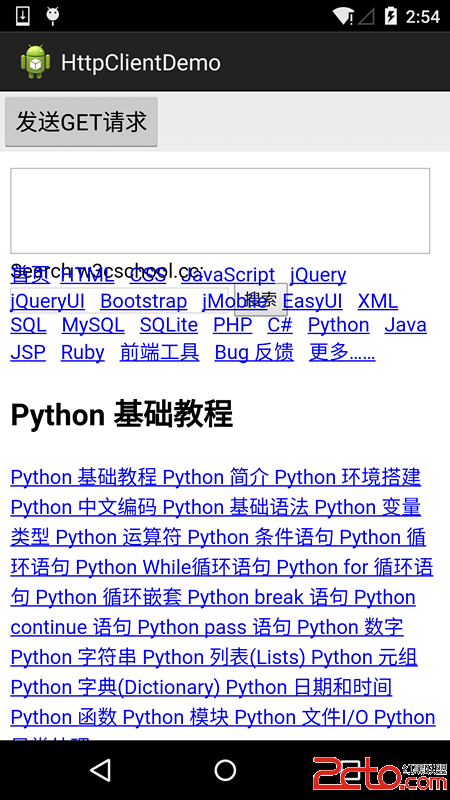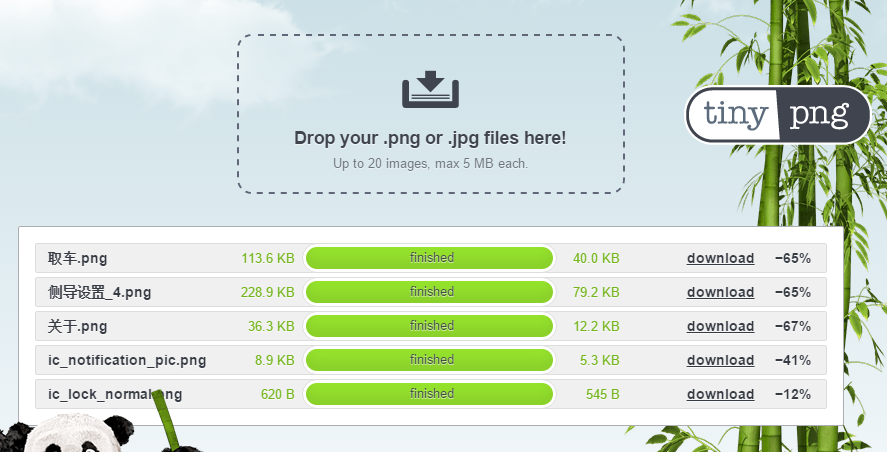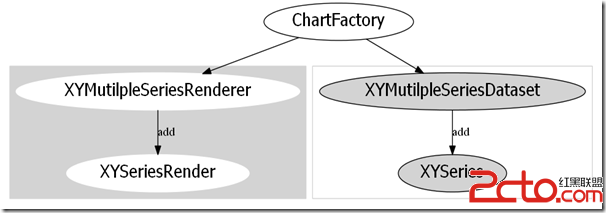編輯:關於Android編程
上節講了HttpURLConnection,本節就到HttpClient了,Apache給我們提供的HttpClient(簡單的Http客戶端),
不過畢竟不是親兒子,HttpClient在API 21版本後就給Google棄用了,而我們實際開發中,很多頁面都不是通過
一個簡單的URL就可以訪問的,可能需要登陸或者相關權限才可以訪問,這就涉及到了Session,Cookie等的問題了;
當然我們可以用HttpURLConnection來實現,但是有點麻煩,而用HttpClient可以簡單點;HttpClient用於接收/發送
Http請求/響應,但不緩存服務器響應,不執行HTML頁面潛入的JS代碼,不會對頁面內容進行任何解析,處理;
要改掉廢話太多的習慣,SO簡化博文,開始本節內容吧:
基本流程:

嗯,就寫個簡單的發送GET請求的代碼吧:
package com.example.httpclientdemo;
import org.apache.http.HttpEntity;
import org.apache.http.HttpResponse;
import org.apache.http.client.HttpClient;
import org.apache.http.client.methods.HttpGet;
import org.apache.http.impl.client.DefaultHttpClient;
import org.apache.http.util.EntityUtils;
import android.app.Activity;
import android.os.Bundle;
import android.os.Handler;
import android.os.Message;
import android.view.View;
import android.view.View.OnClickListener;
import android.webkit.WebView;
import android.widget.Button;
public class MainActivity extends Activity implements OnClickListener {
private Button btnGet;
private WebView wView;
public static final int SHOW_DATA = 0X123;
private String detail = "";
private Handler handler = new Handler() {
public void handleMessage(Message msg) {
if(msg.what == SHOW_DATA)
{
wView.loadDataWithBaseURL("",detail, "text/html","UTF-8","");
}
};
};
@Override
protected void onCreate(Bundle savedInstanceState) {
super.onCreate(savedInstanceState);
setContentView(R.layout.activity_main);
initView();
setView();
}
private void initView() {
btnGet = (Button) findViewById(R.id.btnGet);
wView = (WebView) findViewById(R.id.wView);
}
private void setView() {
btnGet.setOnClickListener(this);
wView.getSettings().setDomStorageEnabled(true);
}
@Override
public void onClick(View v) {
if (v.getId() == R.id.btnGet) {
GetByHttpClient();
}
}
private void GetByHttpClient() {
new Thread()
{
public void run()
{
try {
HttpClient httpClient = new DefaultHttpClient();
HttpGet httpGet = new HttpGet("http://www.w3cschool.cc/python/python-tutorial.html");
HttpResponse httpResponse = httpClient.execute(httpGet);
if (httpResponse.getStatusLine().getStatusCode() == 200) {
HttpEntity entity = httpResponse.getEntity();
detail = EntityUtils.toString(entity, "utf-8");
handler.sendEmptyMessage(SHOW_DATA);
}
} catch (Exception e) {
e.printStackTrace();
}
};
}.start();
}
}
另外,如果是帶有參數的GET請求的話,我們可以把參數放到List集合中,在對參數進行URL編碼:
然後和URL拼接
List params = new LinkedList();
params.add(new BasicNameValuePair("user", "豬小弟"));
params.add(new BasicNameValuePair("pawd", "123"));
String param = URLEncodedUtils.format(params, "UTF-8");
HttpGet httpGet = new HttpGet("http://www.baidu.com"+"?"+param);
接著貼下運行截圖:

POST請求比GET稍微復雜一點,創建完HttpPost對象後,通過NameValuePair集合來存儲等待提交
的參數,並將參數傳遞到UrlEncodedFormEntity中,最後調用setEntity(entity)完成,
HttpClient.execute(HttpPost)即可;這裡就不寫例子了,暫時沒找到Post的網站,又不想
自己寫個Servlet,So,直接貼核心代碼吧~
核心代碼:
private void PostByHttpClient(final String url)
{
new Thread()
{
public void run()
{
try{
HttpClient httpClient = new DefaultHttpClient();
HttpPost httpPost = new HttpPost(url);
List params = new ArrayList();
params.add(new BasicNameValuePair("user", "豬大哥"));
params.add(new BasicNameValuePair("pawd", "123"));
UrlEncodedFormEntity entity = new UrlEncodedFormEntity(params,"UTF-8");
httpPost.setEntity(entity);
HttpResponse httpResponse = httpClient.execute(httpPost);
if (httpResponse.getStatusLine().getStatusCode() == 200) {
HttpEntity entity2 = httpResponse.getEntity();
detail = EntityUtils.toString(entity2, "utf-8");
handler.sendEmptyMessage(SHOW_DATA);
}
}catch(Exception e){e.printStackTrace();}
};
}.start();
}
其實關於HttpClient的例子有很多,比如筆者曾經用它來抓學校教務系統上學生的課程表:
這就涉及到Cookie,模擬登陸的東西,說到抓數據(爬蟲),一般我們是搭配著JSoup來解析
抓到數據的,有興趣可以自己查閱相關資料,至於筆者的畢設,代碼很爛的說,後續有時間
整理在發布出來吧,這裡貼下模擬登陸教務系統部分的代碼,大家可以體會下HttpClient:
//獲得鏈接,模擬登錄的實現:
public int getConnect(String user, String key) throws Exception {
// 先發送get請求 獲取cookie值和__ViewState值
HttpGet getLogin = new HttpGet(true_url);
// 第一步:主要的HTML:
String loginhtml = "";
HttpResponse loginResponse = new DefaultHttpClient().execute(getLogin);
if (loginResponse.getStatusLine().getStatusCode() == 200) {
HttpEntity entity = loginResponse.getEntity();
loginhtml = EntityUtils.toString(entity);
// 獲取響應的cookie值
cookie = loginResponse.getFirstHeader("Set-Cookie").getValue();
System.out.println("cookie= " + cookie);
}
// 第二步:模擬登錄
// 發送Post請求,禁止重定向
HttpPost httpPost = new HttpPost(true_url);
httpPost.getParams().setParameter(ClientPNames.HANDLE_REDIRECTS, false);
// 設置Post提交的頭信息的參數
httpPost.setHeader("User-Agent",
"Mozilla/5.0 (Windows NT 6.3; WOW64; Trident/7.0; rv:11.0) like Gecko");
httpPost.setHeader("Referer", true_url);
httpPost.setHeader("Cookie", cookie);
// 設置請求數據
List params = new ArrayList();
params.add(new BasicNameValuePair("__VIEWSTATE",
getViewState(loginhtml)));// __VIEWSTATE參數,如果變化可以動態抓取獲取
params.add(new BasicNameValuePair("Button1", ""));
params.add(new BasicNameValuePair("hidPdrs", ""));
params.add(new BasicNameValuePair("hidsc", ""));
params.add(new BasicNameValuePair("lbLanguage", ""));
params.add(new BasicNameValuePair("RadioButtonList1", "%D1%A7%C9%FA"));
params.add(new BasicNameValuePair("txtUserName", user));
params.add(new BasicNameValuePair("TextBox2", key));
params.add(new BasicNameValuePair("txtSecretCode", "")); // ( ╯□╰ )逗比正方,竟然不需要驗證碼
// 設置編碼方式,響應請求,獲取響應狀態碼:
httpPost.setEntity(new UrlEncodedFormEntity(params, "gb2312"));
HttpResponse response = new DefaultHttpClient().execute(httpPost);
int Status = response.getStatusLine().getStatusCode();
if(Status == 200)return Status;
System.out.println("Status= " + Status);
// 重定向狀態碼為302
if (Status == 302 || Status == 301) {
// 獲取頭部信息中Location的值
location = response.getFirstHeader("Location").getValue();
System.out.println(location);
// 第三步:獲取管理信息的主頁面
// Get請求
HttpGet httpGet = new HttpGet(ip_url + location);// 帶上location地址訪問
httpGet.setHeader("Referer", true_url);
httpGet.setHeader("Cookie", cookie);
// 主頁的html
mainhtml = "";
HttpResponse httpResponseget = new DefaultHttpClient()
.execute(httpGet);
if (httpResponseget.getStatusLine().getStatusCode() == 200) {
HttpEntity entity = httpResponseget.getEntity();
mainhtml = EntityUtils.toString(entity);
}
}
return Status;
}
好的,本節關於HttpClient就到這裡吧,內容還是比較簡單的~
下節我們將使用retrofit來封裝我們的HTTP請求,敬請期待~
對了,關於Android裡簡單的網絡技術可以參考小豬之前寫過的入門系列:
 android產品研發(四)--)減小Apk大小
android產品研發(四)--)減小Apk大小
隨著移動技術的深入發展,各種炫酷效果的更新,在我們追求UI與UE的同時一個不如忽視的問題逐漸暴露出來,那就是apk文件越來越大,可能有的童鞋會說現在都是wifi環境,ap
 Android入門:多線程斷點下載詳細介紹
Android入門:多線程斷點下載詳細介紹
本案例在於實現文件的多線程斷點下載,即文件在下載一部分中斷後,可繼續接著已有進度下載,並通過進度條顯示進度。也就是說在文件開始下載的同時,自動創建每個線程的下載進度的本地
 Android中的腦殘設計總結
Android中的腦殘設計總結
Trackball軌跡球 這有點類似於PC上面的鼠標,可以用於導航,為此便有了Focus,但是這實際操作意義並不大,因為整個屏幕都是觸控的,還用導航干什麼,先把Focus
 Android 圖表繪制 achartengine 示例解析
Android 圖表繪制 achartengine 示例解析
一. AChartEngine 簡介 1. 項目地址 AChartEngine 簡介 : AChar